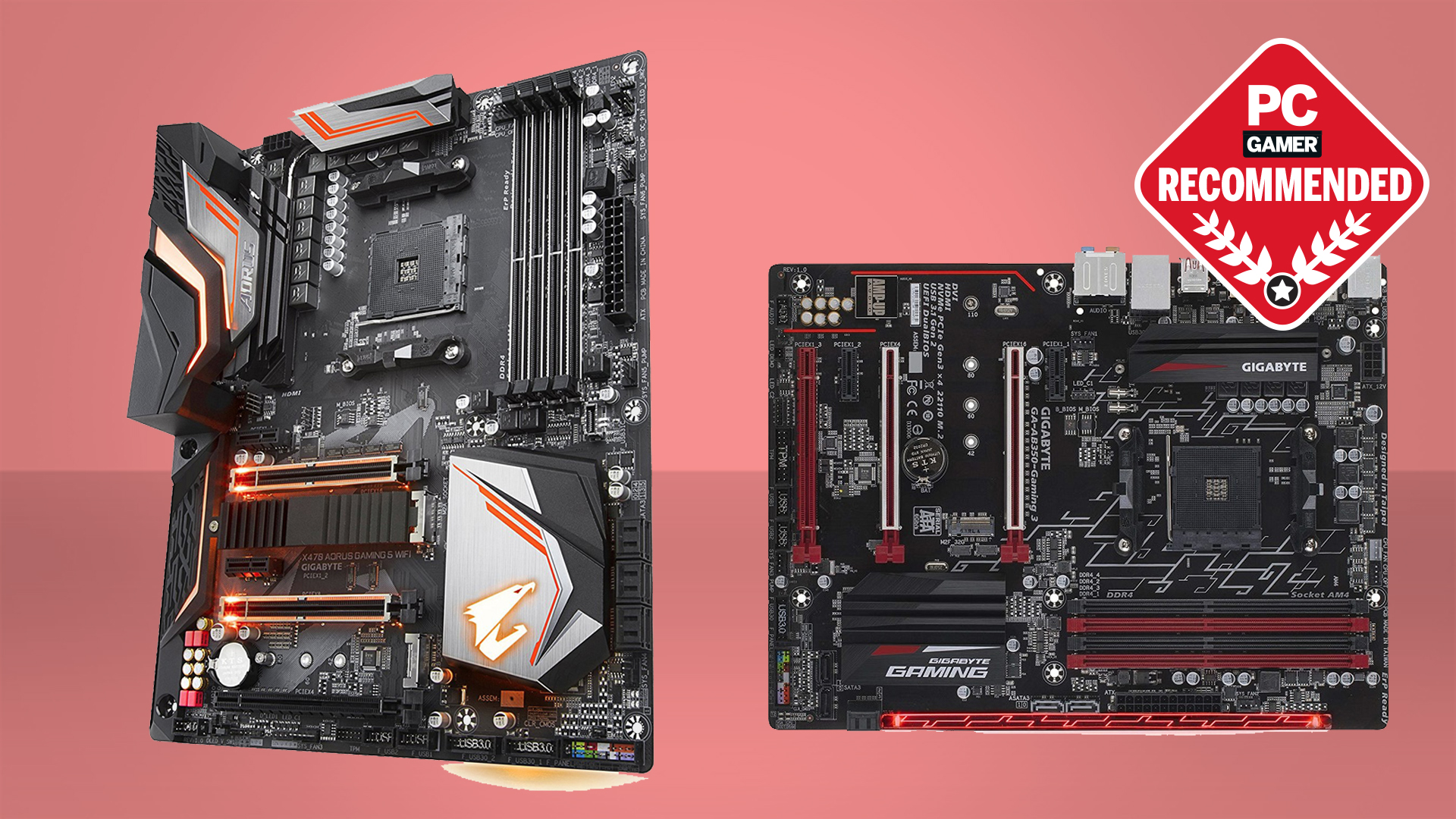The best AMD motherboards

If you’re building a new PC with a Ryzen CPU, it is absolutely vital that you pick up one of the best AMD motherboards. If you’re here, you probably already know that the motherboard is the foundation of your PC and the glue that holds all your components together and lets you take advantage of the high-end specs found in the best graphics cards and the best CPUs for gaming. And with the arrival of AMD's 3rd generation Ryzen 3000 CPUs, picking the best motherboard for your AMD build is even more critical.
Of course, choosing a motherboard has a more direct impact on what your PC can do beyond letting your components shine. Choosing the right mobo will determine how many PCIe and M.2 slots you have to work with during your build, and how many USB and other ports you have to work with after you’re done.
Some of you might be tempted to buy used or dated, because a couple of chipset generations are often viable with any given processor, but splurging for the latest models gives you a better chance of being able to keep it when it comes time to upgrade. I recently replaced my motherboard and CPU, and it's more intense than most upgrades. I would recommend future-proofing as much as you can whenever you make a swap.
Lastly, not every motherboard supports processor overclocking and using two GPUs (not that we recommend SLI or CrossFire for gaming purposes these days). If that's part of your plan, make sure the motherboard supports those features. Overclocking should be fine on any X-series or B-series chipset (X370/X470/X570 or B350/B450), while you'll be best off with an X-series chipset for multi-GPU use.
MSI MPG X570 GAMING PRO CARBON WIFI
Specifications
Reasons to buy
Reasons to avoid
The MSI MPG X570 represents an amalgamation of bleeding-edge motherboard tech, built to help you get the most out of AMD's 3rd gen Ryzen CPUs. It has four DIMM slots that can handle speeds up to 4400MHz (there's not much point going beyond DDR4-3800) and two M.2 slots sporting PCIe 4.0. MSI's MPG X570 is all about getting the most out of the best components.
The rear I/O panel features 7 USB-A ports for peripherals, as well as a single USB-C port for connectivity and high-speed data transfer. There are headers for the included wireless antenna to help with wireless connectivity, as well as a gigabit Ethernet port. The MPG X570 does support Wi-Fi 6, and while that does necessitate a Wi-Fi 6 compatible router for the fastest speeds, it will also work with existing Wi-Fi 4/5 routers (formerly 802.11n and 802.11ac). Also of note is the HDMI port, which many X570 boards omit (not that we'd really recommend using an AMD APU with integrated graphics in a high-end board like this).
The pair of M.2 slots each have a dedicated heat shield and fan, and while this does help prevent potential thermal throttling, it makes installing or replacing them a more delicate process than with their exposed counterparts. Frequent part swappers are better off without the heat shield.
The MPG X570 features enough compatibility to get the most out of your hardware now and in the future, provided you're willing to pay a premium for it. While it's certainly an excellent mobo, if you aren't already committed to a shopping list of top-of-the-line components now or in the near future, you may want to consider a slightly less expensive board for your needs. The MSI X570-A Pro omits some of the extras like Wi-Fi and the M.2 shields, but it still runs fine and costs much less.
Asus ROG Crosshair VIII Hero (Wi-Fi)
Specifications
Reasons to buy
Reasons to avoid
The Asus ROG Crosshair VIII Hero (Wi-Fi) is another excellent if opulent board for 3rd gen Ryzen processors. This gaming motherboard comes packed with all of the trappings you'd expect, including an on-board thermal sensor, onboard power and reset buttons, and a BIOS flashback option on the rear IO panel. The board even has it's I/O shield pre-mounted to avoid any embarrassing mishaps after you've screwed in all of the stand-offs.
This standard ATX board can support a pair of GPUs in its PCIe ports and up to 128GB of RAM with its four DIMM slots along with a pair of M.2 SSDs. These specs are generally par for the course, however, an array of 10 USB-A ports as well as USB-C support for a front panel connection provide ample support for any number of peripherals, which helps put this board a cut above its peers.
Sleek matte black and chrome finish and subdued RGB lend an air of subtlety to this particular board, and while the seamless M.2 heat shields make the Crosshair one of the cleanest looking boards on this list, it does make swapping out SSDs a bit problematic. This isn't a glaring issue but does add an extra step whenever you're trying to upgrade your storage. Overall, this board has tons of attractive features, but its comparatively steep price tag may draw your eye to more affordable offerings.
ASRock Fatal1ty B450 Gaming-ITX/ac
Specifications
Reasons to buy
Reasons to avoid
Packing even a mainstream chipset into a mini-ITX board usually means deep cuts, the inevitable sacrifice of a number of features in favor of that smaller form factor. ASRock's Fatal1ty B450 Gaming-ITX/ac stands out from and increasingly crowded mini-ITX crowd by fielding a petite board without slicing off any of the most important selling points.
You get excellent performance-per-dollar with excellent overclocking support for both the CPU and memory. It's competitive in performance terms with most X470 boards at a significant price discount, really only losing a handful of USB ports in the move to mini-ITX. If you're looking for a small but highly capable mobo at an excellent price, look no further.
Gigabyte Aorus AX370 Gaming 5
Specifications
Reasons to buy
Reasons to avoid
Unsurprisingly, the X370 version in the Auros stable is also an excellent board, a fantastic, inexpensive mobo that will still satisfy the majority of gaming builds. While it's not really optimized for overclocking (our testing with a Ryzen 7 1700X chip peaked at 4GHz), it's an excellent option for anyone looking to shave a few dollars off their motherboard cost to tuck into other more vital components.
It does lack Wi-Fi and Bluetooth, so if you're not parking it next to a handy Ethernet connection you may want to reconsider (you'd be better spending the few extra dollars a Wi-Fi card would cost you upgrading to a board that natively supports it), but is otherwise a fully featured, highly capable motherboard that can be had at a very reasonable price.
Gigabyte AB350-Gaming 3
Specifications
Reasons to buy
Reasons to avoid
If you're in the market for a B350 board at a great price that's still loaded up with features, Gigabyte's AB350-Gaming 3 is an excellent choice. It packs 4 DIMMs with support for up to 64 GB of RAM and a full three PCIe slots (though only the top lane gets a full serving of bandwidth). There's a raft of USB ports, including speedy 10Gbps USB 3.1 2nd gen, and robust support for RGB lighting effects, if you've got a tempered glass window on your case and want to showcase your internals.
The AB350 is a perfect example of trimming away fat to provide an excellent board at the lowest possible price, something Gigabyte excels at (as the rest of this roundup has proven in spades). For an AMD build with a responsible budget, it's one of the best options available.
The biggest gaming news, reviews and hardware deals
Keep up to date with the most important stories and the best deals, as picked by the PC Gamer team.


